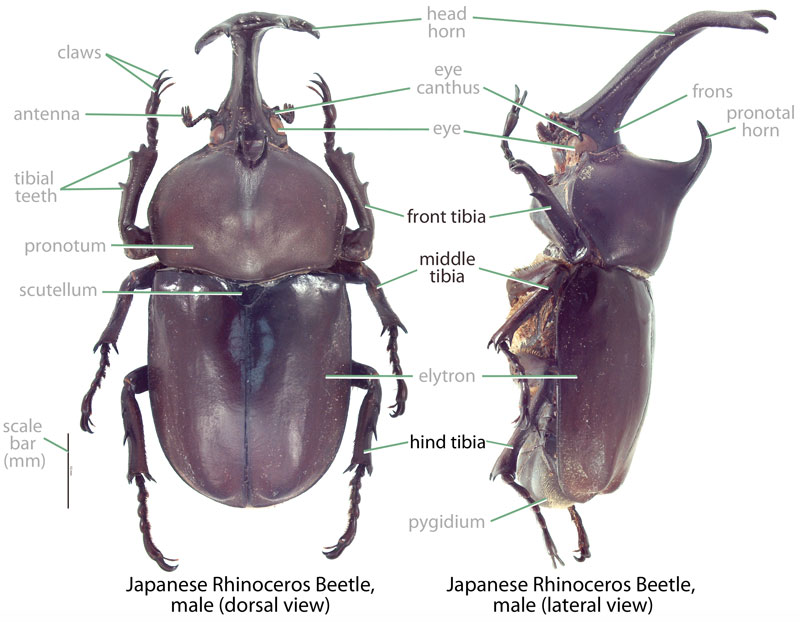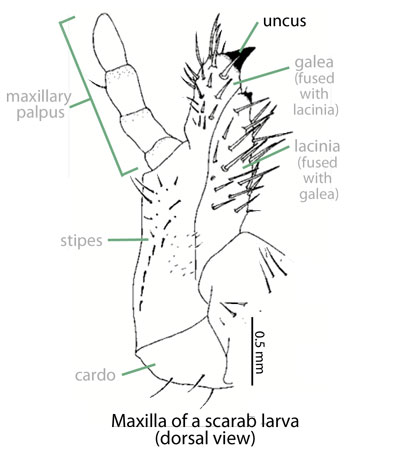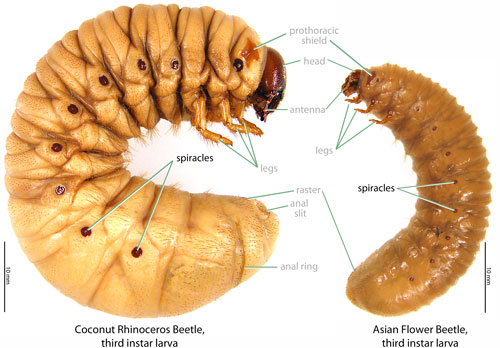Potential Invader
green chafer
Family: Scarabaeidae Subfamily: Rutelinae Genus: Anomala Species: Anomala viridana (Kolbe, 1886)
none available
Total body length 18.0–24.0 mm (0.71–0.94 in). Body shape ovate. Color brownish-green with metallic sheen. Front tibiatibia:
a segment of the leg articulated with the tarsus and femur
 with two external teeth; apical toothtooth:
with two external teeth; apical toothtooth:
a pointed process from an appendage or margin, often in reference to the tibia
long, longer in female than male; basal toothtooth:
a pointed process from an appendage or margin, often in reference to the tibia
feeble in male, more evident in female. Front inner claw bifurcatebifurcate:
a process dividing into two points
; bifurcatebifurcate:
a process dividing into two points
claw strongly sinuatesinuate:
gently curved (specifically of margins or edges); often in reference to the clypeus
in male, simple in female. Hind tibiatibia:
a segment of the leg articulated with the tarsus and femur
 with inner margin simple, not greatly dilated at the middle.
with inner margin simple, not greatly dilated at the middle.
Undescribed. For Anomala (Ritcher, 1966Ritcher, 1966:
Ritcher P. 1966. White grubs and their allies: a study of North American scarabaeoid larvae. Oregon State University Monographs, Studies in Entomology 4: 1-219.): Grub C-shaped, not hump-backed, cylindrical, whitish. Lacinialacinia:
inner portion of the maxilla of maxillamaxilla:
of maxillamaxilla:
set of paired mouthparts located posterior to the mandibles
with 2 apical unciunci:
in scarab larvae, a hooked process on the distal margin of the maxilla
 equal in size. Maxillary stridulatory area with 4–7 sharp, recurvedrecurved:
equal in size. Maxillary stridulatory area with 4–7 sharp, recurvedrecurved:
bending backwards
teeth. Epipharynxepipharynx:
lobe on the interior surface of the labrum or clypeus
with 2–4 prominent heliheli:
in scarab larvae, a coarse spine on or near the haptomerum
. Final antennal segment with single dorsaldorsal:
of or relating to the upper surface; opposite of ventral
sensory spot. Spiraclesspiracles:
opening on the abdomen or thorax through which air enters and exits the body
 on abdominal segments 7 and 8 similar in size and conspicuously larger than spiraclesspiracles:
on abdominal segments 7 and 8 similar in size and conspicuously larger than spiraclesspiracles:
opening on the abdomen or thorax through which air enters and exits the body
 on abdominal segments 1–6. Anal slit transversetransverse:
on abdominal segments 1–6. Anal slit transversetransverse:
extending horizontally across a surface
, arcuatearcuate:
curved, arched, or bow-shaped
; bordered by several irregular rows of stout setaesetae:
small, hair-like structure
. Lower anal lip bearing patch of 13 hamatehamate:
hook-like in shape
setae.
Northeast Asia. This species has been recorded from Japan (Kobayashi and Matsumoto, 2011Kobayashi and Matsumoto, 2011:
Kobayashi H and Matsumoto T. 2011. Atlas of Japanese Scarabaeoidea. Volume 2 Phytophagous Group I. Roppon-Ashi Entomological Books, Tokyo, Japan.), Korea (Park et al, 2014Park et al, 2014:
Park S, Lim H, Kim D. 2014. A survey on insect diversity of Baengnyeongdo, Korea. Journal of Asia-Pacific Biodiversity 7: 268-280. DOI (accessed 2015)), and Sakhalin and the Kurile Islands in the Russian Far East (Bezborodov, 2014Bezborodov, 2014:
Bezborodov V. 2014. Lamellicorn beetles (Coleoptera: Scarabaeoidea) of the Kuril Islands (Sakhalin Region, Russia): taxonomical structure, fauna, ecology and zoogeography. Caucasian Entomology Bulletin 10 (1): 33-46. full text (accessed 2015))
In the Kurile Islands, adults of this chafer have been recorded on the herb sea-watch or seacoast angelica (Angelica lucida) (Krivolutskaya, 1973Krivolutskaya, 1973:
Krivolutskaya G. 1973. Entomofauna of the Kuril Islands: Principal Features and Origin. Izdatel'stvo Nauka, Leningrad Division. 315 pp. Translated from Russian by E Urdang. Available from http://www.burkemuseum.org/static/okhotskia/ikip/Results/publications/entobook/title.htm (accessed 2015).) as well as northern water hemlock (Cicuta virosa), hemlock-parsley (Conioselinum chinense), and giant knotweed (Fallopia sachalinensis) (Bezborodov et al., 2011Bezborodov et al., 2011:
Bezborodov V, Aistova E, Rogatnykh D. 2011. Anthophilous Plastinchatousye beetles (Coleoptera, Scareabaeidae) Russian Far East. Amur Zoological Journal 3: 20-34.).
Poorly known. Presumably, the life history of this species is similar to that of the closely related oriental beetle (Anomala orientalis). LarvaeLarvae:
the immature form of an insect; in scarabs, also called grub or white grub; preceded by the egg stage, followed by the pupal stage
 develop in soil where they feed upon the roots of a number of plant species. Adults are likely nocturnal, generalist folivores.
develop in soil where they feed upon the roots of a number of plant species. Adults are likely nocturnal, generalist folivores.
Low. This species has been recorded on Wake Island in abundance (Hawaiian Entomological Society, 1953Hawaiian Entomological Society, 1953:
Anonymous. 1953. Proceedings of the Hawaiian Entomological Society for the year 1952. Proceedings of the Hawaiian Entomological Society 15: 373-390. full text (accessed 2015)) and potentially could spread to Hawaii or Guam. It is not apparent that Anomala viridana causes significant damage to plants of horticultural or agricultural importance, but native plants could possibly be impacted.
Recorded, not established. This species was recorded in 1952 as a hitchhiker on aircraft coming to Honolulu airport from Wake Island where it is, or was, established and abundant (Hawaiian Entomological Society, 1953Hawaiian Entomological Society, 1953:
Anonymous. 1953. Proceedings of the Hawaiian Entomological Society for the year 1952. Proceedings of the Hawaiian Entomological Society 15: 373-390. full text (accessed 2015)).
Not established or recorded. There are no records of this species from Guam.
Although this species is temperate in origin, its establishment on Wake Island demonstrates its ability to survive in tropical climates. As such, it should be regarded as having the potential to spread to both Hawaii and Guam. Further, the possibility of the introduction of the Anomala viridana to the mainland U.S. must also be considered. As previously mentioned, this species is a known hitchhiker on aircraft, and it is reasonable to expect that marine cargo also represents a potential vehicle of introduction.
Anomala viridana is one of five Anomala species recorded from Hawaii and Guam, along with Anomala orientalis, Anomala sulcatula, Anomala cuprea, and Anomala albopilosa. It can be separated from the other species by examination of the bifurcatebifurcate:
a process dividing into two points
male front claw (strongly sinuatesinuate:
gently curved (specifically of margins or edges); often in reference to the clypeus
in A. viridana versus weakly sinuatesinuate:
gently curved (specifically of margins or edges); often in reference to the clypeus
in A. albopilosa and curved but non-sinuate in A. orientalis and A. sulcatula), male hind tibiatibia:
a segment of the leg articulated with the tarsus and femur
 (A. cuprea with hind tibiatibia:
(A. cuprea with hind tibiatibia:
a segment of the leg articulated with the tarsus and femur
 not greatly dilated at the middle on the inner margin versus hind tibiatibia:
not greatly dilated at the middle on the inner margin versus hind tibiatibia:
a segment of the leg articulated with the tarsus and femur
 dilated at the middle in A. sulcatula), and total body length (A. cuprea 17.0–26.0 mm [0.67–1.02 in] versus less than 13.0 mm [0.51 in] in A. orientalis).
dilated at the middle in A. sulcatula), and total body length (A. cuprea 17.0–26.0 mm [0.67–1.02 in] versus less than 13.0 mm [0.51 in] in A. orientalis).
Anomala borealis Arrow, Anomala izuensis Sawada, Anomala japonica Arrow, Euchlora mongolica Lewis, and Euchlora viridana Kolbe
In Hawaii, this species represents a new invasiveinvasive:
a species that has recently arrived to a new location, usually via human activity, causing notable economic and/or ecological damage
species. Prevent the spread of this species by reporting your observation at our iNaturalist project.